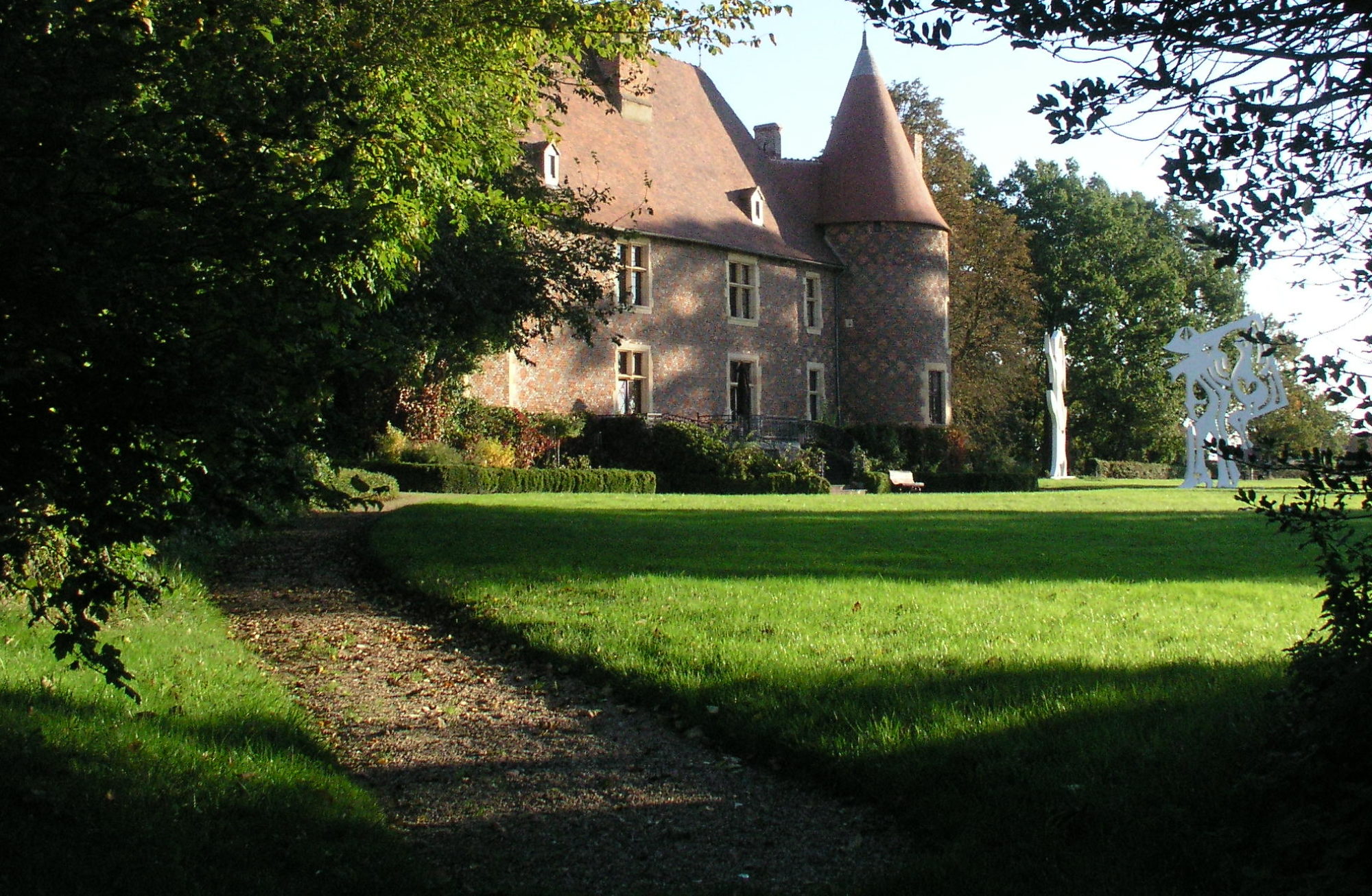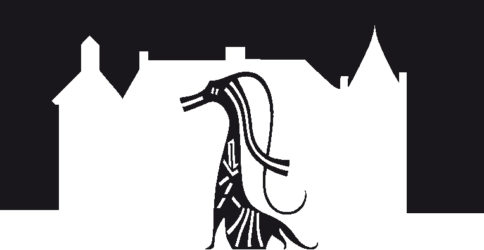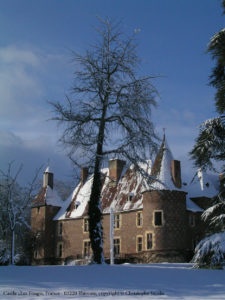UN CHATEAU BOURBONNAIS
ET LE JARDIN MERVEILLEUX
D’ERICH ENGELBRECHT
Le Château des Fougis est la propriété privée de la famille de l’artiste allemand Erich Engelbrecht décédé en 2001. Elle y demeure en permanence.
La propriété comporte :
- Un château du XVIe siècle élevé en briques rouges et noires, représentatif des styles architecturaux de la Renaissance française bourbonnaise.
- Des appartements, expositions d’art, cours et des jardins dont entre autres, ce “jardin merveilleux d’Eric Engelbrecht” avec un parcours en plein air de 28 immenses sculptures en acier.
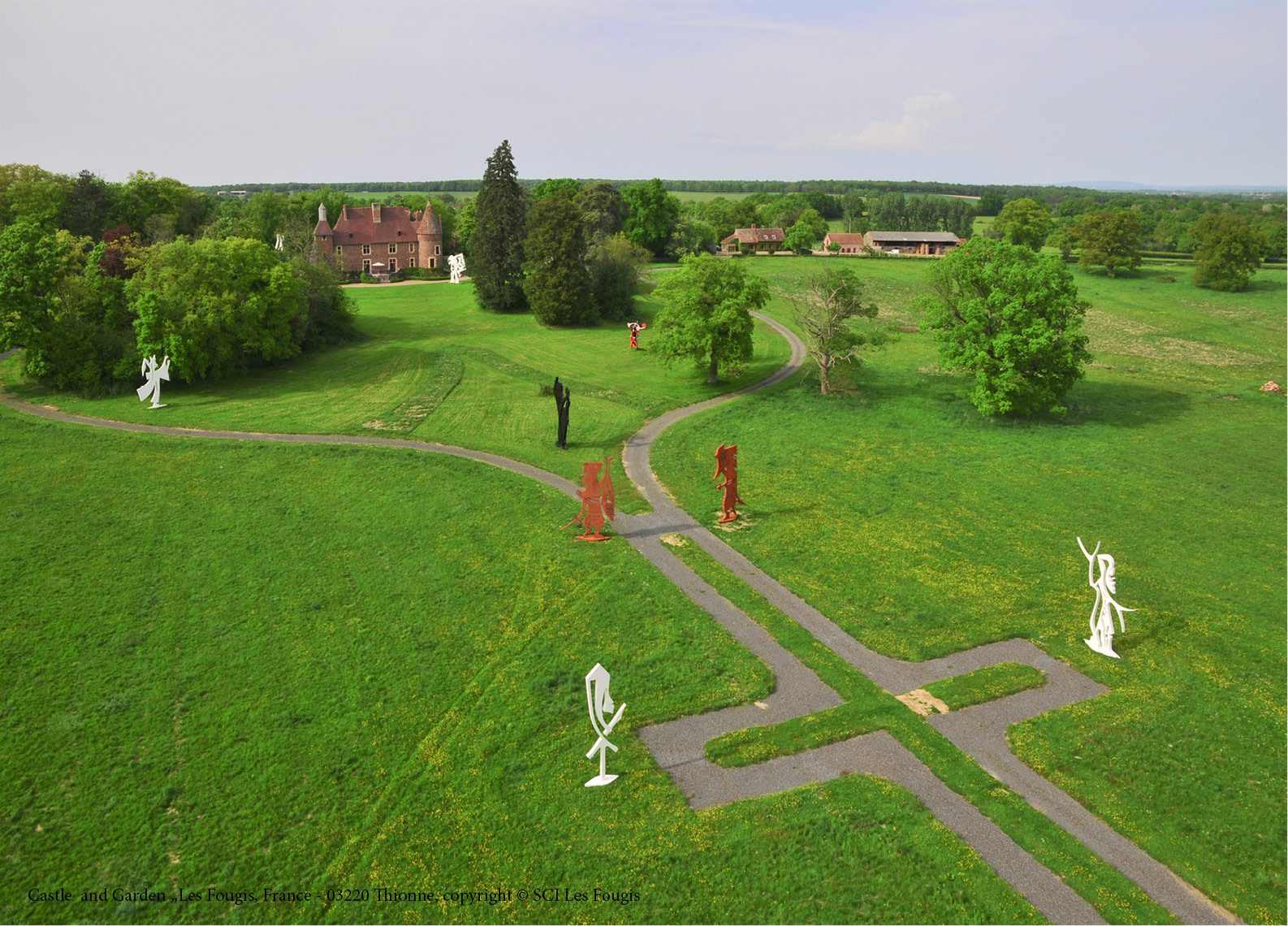
Les œuvres artistiques d’Erich Engelbrecht exposées aux Fougis sur les propriétés familiales ont été fabriquées en Allemagne dans le cadre du projet artistique majeur qui l’animait jusqu’à la fin de sa vie. Des sculptures dressant leur silhouette dans les airs à 12 mètres de hauteur et pesant jusqu’au delà de 100 tonnes, sont réparties dans les champs vallonnés de la propriété onirique. Ces sculptures monumentales en acier entourant le château sont des œuvres à couper le souffle. Elles suscitent souvent déjà la surprise ou l’admiration des passants depuis l’agréable route de campagne qui rejoint la ville de Moulins.
Trois maisons individuelles servent pour les propriétaires et leurs invités
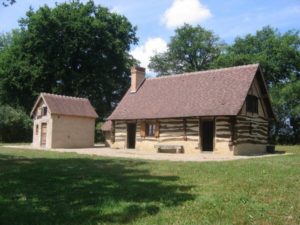
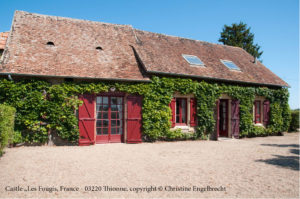
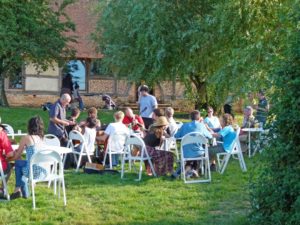
- Un bâtiment servant pour des événements et réceptions publiques peut accueillir à l’intérieur jusque 80 personnes
- Les bâtiments sont entourés de 130 hectares de plaines bocagères, d’étangs poissonneux, de routes en gravier, et de sentiers forestiers
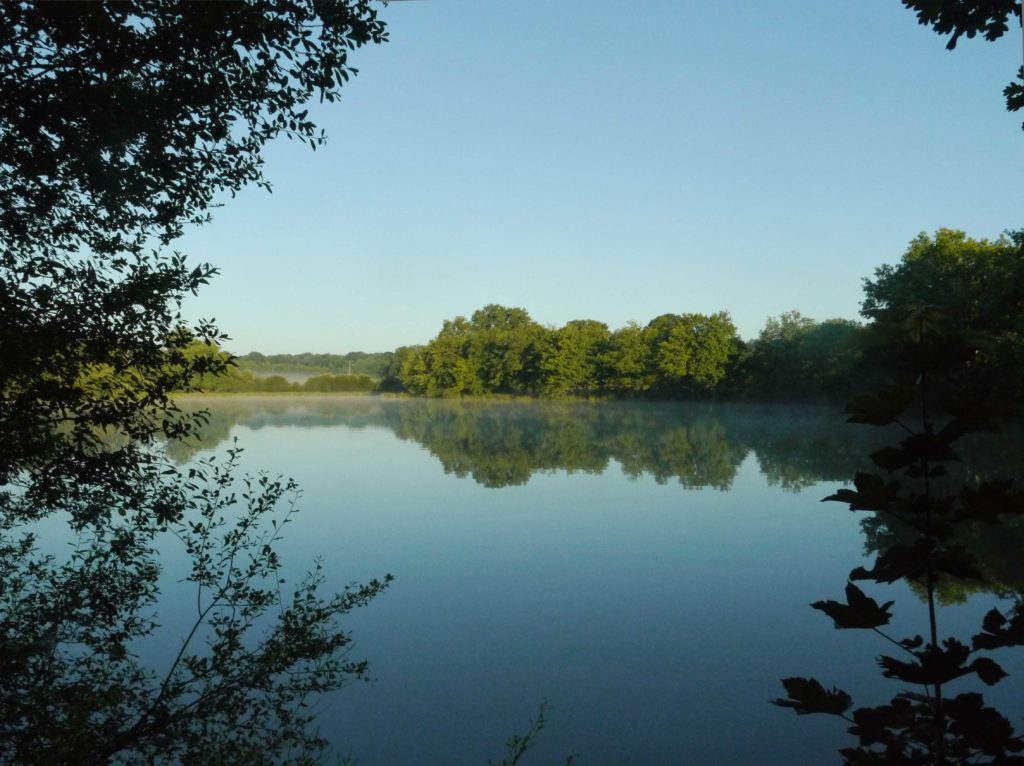
Location
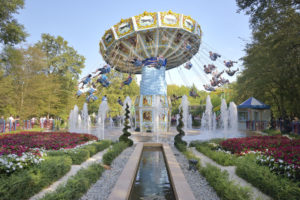
The castle is located in the municipality of Thionne – an old French village perched on a picturesque ridge in the Bresbre River valley – which lies 15 kilometers from the PAL (one of France’s biggest amusement parks).
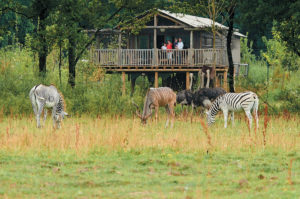
In our village “Thionne” the well-known writer Rene Fallet was born. He wrote, inter alia, the famous film “La soupe au choux” – the cabbage soup – with Louis De Funes in the lead role.
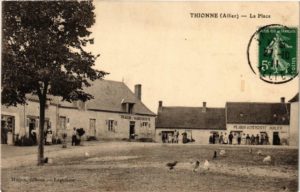
Two old french countrymen are living a quiet life in their little village. They spend their days drinking liters of wine and cabbage soup (traditional specialty of our region), reminding themselves the good old times. One evening, they happen to start a farting contest – due to the effects of their famous cabbage soup – which seems to provoke a lightning storm and the arrival of an extraterrestrial in their little garden…
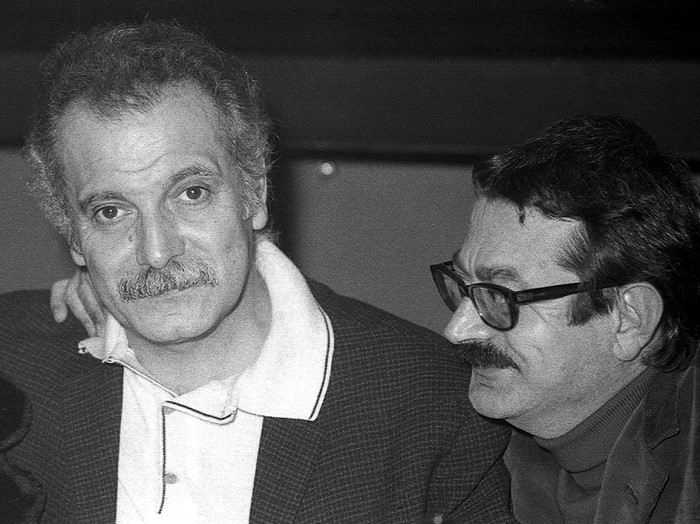
Access
The castle is accessible by the scenic country road which connects the villages of Thionne and Chapeau. Visitors can arrive by car from the nearest train station (15 kilometers away in Dompierre-sur-Bresbre). Next bigger cities are Moulins at 30 km (main city of the department Allier) and Vichy at 40 km (beautiful old European Spa City).
Clermont Ferrand – main City of the French Auvergne – 100 km from Thionne, has a regular airport
The famous city of Lyon is a 2 hour ride from Thionne. Visitors who arrive by plain in Lyon should rent a car or continue traveling by train to Moulins or Dompierre.
Paris connects to Moulins by train within a 2h30 ride.

The Tourist Environment
The Allier, the central French department where the castle is located, saw 6.8 million overnight stays of tourists in 2017. The region offers:
-47 castles open to visitors
-75 museums and permanent exhibitions
-Countless picturesque Roman, medieval, Renaissance villages
– Vichy, Famous European Spa City with three public spas and hot springs
A principal departmental objective: develop regional, national, and international tourism. The Allier department has signed an agreement with the Auvergne region to develop tourism; as such, there are new policies to support tourism investment projects.
-“Le tourisme de Mémoire:” Each year, “Memory tourism” draws around 12 million tourists in France to visit cultural and historical landmarks. Coming to understand the experiences of World War II soldiers should be a theme of fundamental importance of memory tourism in France. Currently, no French art collection offers the perspective of a young German soldier; no displayed work of art in France stems from the traumatized psyche of a teenager forced to fight on the side of the Nazis. The lasting effects of his participation in World War II can be seen and felt in Engelbrecht’s complex and beautiful art.
The Allier department only has one museum dealing with the theme of World War II memory: the Museum of the Resistance of Montlucon. Therefore, there is a valuable lesson to be offered to people—from school-aged local children to aging foreign tourists—on the artistic expression compelled by trauma and the universality of wartime suffering.
The artist Erich Engelbrecht
Erich Engelbrecht’s work is primarily inspired by fairy tales and Jungian archetypes. Taoist and Jungian philosophy, is a very avant-garde approach in France. Witnessing the originality of this creative approach is an artistic and cultural asset to school-aged children around France. Learning about Engelbrecht’s creative approach can be especially complementary to high school students who receive a philosophy curriculum in their final years.
An Unexpected Work
Unexpected—certainly the word that most aptly corresponds to a visit within the astonishing work and mind of Erich Engelbrecht, a revered German artist who came to create his largest body of work at the Chateau des Fougis in Thionne, a French village of 326 inhabitants. The monumentality of his works that decorate the agricultural landscape surrounding Les Fougis is nothing short of unexpected. Similarly unexpected is the technique of creating these works: drawing and cutting a sheet of steel that can measure up to 12 meters high and weigh 130 tons— where the space is as meaningful as the emptiness. Equally unexpected is the complex inspiration of the artist: the trauma of participation on the Nazi front in World War II as a young teenager; myths and fairy tales; and Jungian and Taoist philosophy.
A Setting of Heritage and History
The sculpture park is set in a calculated and aesthetic manner around the 16th century castle. The castle serves as a beautiful backdrop for the sculptures and offers a visit to a site of historic and cultural heritage to all. The sculptural works related to medieval fantasy tales for a coherent whole within the surreal castle setting, and give the visitor a rich, dream-like experience. Erich Engelbrecht was fascinated by the calculated, symbolic positioning of his work to make it most impactful to the visiting public; as such, the positioning of the sculptures carries equal weight as a part of his creative process.
For this purpose, the artist created a 1.2 km long walk through the park, which has the shape of a giant anchor. This anchor symbolizes our connection in the subconscious and guides the visitor through the sculpture exhibition.
The Trauma of World War II
Enlisted in the Wermacht at age 14, Erich Engelbrecht fought two years on different fronts. On May 8, 1945 at the end of the war, Engelbrecht was a mere 16 years of age; the unimaginable traumas he experienced would surface again and again in his lifetime artistic production.
Tales and Sagas
The universality of fairy tales, myths, and archetypal characters fascinated Engelbrecht and allowed him to develop a language to convey ideas through the physical transmission of these stories. Characters, animals, and objects that mingle in dialogue—together, within a single sculpture—convey many hidden meanings which the public can attempt to decode through careful and creative observation of the work. The integration of themes of fantasy and fairy tales make his work accessible to all audiences.
Taoist and Jungian Philosophy
Chinese Taoism and the psychoanalytical and philosophical thought of Carl Jung profoundly affected Erich Engelbrecht. Also a German, Jung’s philosophy and socio-cultural writings are greatly influenced by the “Tao,” the universal flow that permeates everything, and which an artist can tap into for inspiration. Engelbrecht’s work brings these important bodies of thought together in an artistic and architectural masterpiece. Every visitor who will be able to contemplate the nature of these ideas will be greatly inspired and have parts of their minds opened they never knew existed. Engelbrecht’s work has the potential to evoke a variety of feelings in the visitor, but the sculptures return us to a sense of universality from which our consciousness—and therefore, unconsciousness and the myths that spring from these realms—emerges.
Obviously, the family speaks fluent German and would be delighted to welcome German students and tourists—and it’s not so often that Germans can be perfectly communicated with in France.
Reservations for guided tours in French / German / Englisch:
Analysis and Reflection on the Collection
The Creation of a New Tourist and Cultural Site in the Allier
The promotion of Erich Engelbrecht’s work is of tantamount importance to creating a new, inspirational cultural site in the Allier. The developmental project must therefore take into account current statistical data and other factors when making definitive plans.
Find a Way to Entice Visitors to Discover Modern Art
In general, modern art is not appreciated by wider publics. The little knowledge about contemporary works makes audiences stay in fear of misunderstanding them.
Thanks to the universal dimension of Engelbrecht’s art, the sculptural park and castle has the potential to appeal to wide audiences.
The physical viewing setting of Engelbrecht’s marvelous sculpture park eases the approach: The works are monumental and interact with the landscape; the works are arranged to be discovered as a journey by the viewer—like an archetypal hero quest and they are in dialogue with their environment. Walking through the path of the sculpture park is therefore to be greatly appreciated—both consciously and unconsciously—by visitors. Thanks to the intersectionality of Engelbrecht’s work—between Eastern thought, traumas of European war, psychology, philosophy, art and sculpture—there is much to discover and much inspiration to be absorbed.
The Wondrous garden in Les Fougis relies on the intersectionality of the works; they are not to be enjoyed by modern art lovers alone, but they speak to the universality of the human experience and depth of the mind.
Invitation to the Discovery of Art through a Fun Walk
On the other hand, the sculptures of Erich Engelbrecht have a playful dimension. Cats, fish, monkeys, princes and princesses, heroes and other characters and images hide within the 10-meter-high works. The shapes, characters, and designs created by filled space and left emptiness transform the works into games of finding the hidden stories and messages.
This is a frank invitation to contemplation and dreaming.
Upcoming Transformations
Enhance the Work by Curating the Setting of the Landscape
The discovery and promotion of this Wondrous Garden in Les Fougis should go hand in hand with the enhancement of the environment in which it is placed.
The actual priority consists in stabilizing, designing, and beautifying the path desired by the artist and magnifying the sculptures with a suitable plant base. The first step in the process of renovation will be a clear drawing of the path in the shape of an anchor by adapted materials.
The environment of the landscape must be designed in a highly calculated manner in a way that makes it discernably different from that of the surrounding agricultural landscape. Therefore are needed plants adapted to the given central French climate, requiring little maintenance, characteristic of the agricultural landscape
Picnics should be a welcomed idea to attract families to take their time at the site. The landscape must allow children to frolic freely; there must be ample shade; there must be water fountains; there must be relevant and necessary educational opportunities strategically placed throughout the park. Finally, recurring events must be planned for the cultural sites: nighttime visits in summer or winter; themed picnics, festivals, etc.
The final product will not be a traditional museum, per se, but rather a “Garden of Wonders,” a project which echoes the themes of the fairy tales and myths which live within Engelbrecht’s work; the notions of self-discovery and universal wonder; the unbelievable size of the works.
Each sculpture is a point of self-discovery, and this reality would be amplified with relevant educational tools including: The story of the work; the meaning of the work; the creative process of the work; the technique.
Suggested Mediation/Informative/Interpretative Tools
Information boards
Marked trails
Invitations to watch
Invitations to contemplate
Unique or unexpected furniture
Integrated discovery stations
Inspiration to global, universal thinking
Lighting
The creation of a central kiosk with a view of the sculptures.
Guest exhibitions of other sculptors are an interesting option, once the garden has been restored and completed.
The unfolding of the project must occur in phases. These phases shall be realized as principal events over a five-year timetable. They would be the stages of growth, an extension of the foundational project consisting of preparing the chateau grounds for visits.
The intersectionality/polysemy of Engelbrecht’s work; its integration with the landscape; its monumentality.
1 – Invitation to Contemplation
The monumentality of the works is striking; to apprehend the complex meaning, you have to be able to contemplate them. The invitation to contemplation would be facilitated with fitting placement of furniture: lounge chairs, picnic tables/mats, shade-covered benches—for example—would give viewers the necessary space for spiritual contemplation on the meaning of Engelbrecht’s work. The placement of this furniture and architecture must be in accordance with the design of the garden and Engelbrecht’s original, outlined intentions.
2 – Invitation to Read/Interpret the Work
The answers/key meanings of the works should not be given immediately. Like in a quest, the visitors must immerse themselves in the sculptures and give themselves over to total perception, overarching sense experience, as they observe the forms and silhouettes.
3 – Discovery of Symbolism
The discovery of the artist-intended symbolism would be done secondarily by physical tools (informational boards, etc.) or by insightful tour guides. Each form must be explained and the context understood. Just like in a quest, after clues upon clues, the essential meaning of the quest appears.
4 – Discovery of the History of the Work
Finally, after the layers of discoveries, readings, contexts, and analyses, historical and artistic interpretations and information can be made and given, respectively.
The Different Phases of the Creation of Erich Engelbrecht’s Garden of Wonders
At this stage in the reflection, it appears that the first phase of the project is the recreation and refurbishment of the main pathway of the visit. It requires:
The recovery of the path in materials determined in accordance with a professional landscaper
The creation of a landscape border along the path to emphasize its directionality through the sculptures, effectively binding them all and creating a cohesive garden.
The creation of devices (lighting, etc.) through which to develop the concept of “Wonder” and the presentation of the works.
The creation of “Discovery Stations” in congruence with other educational tools.
